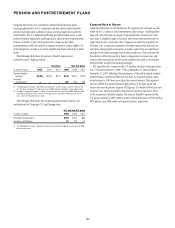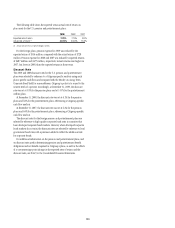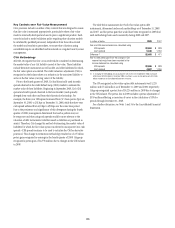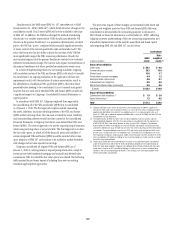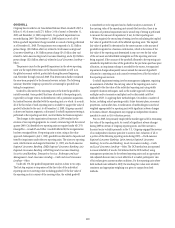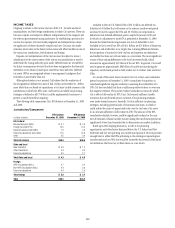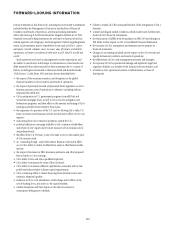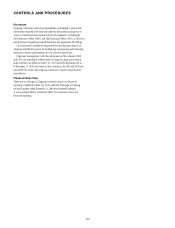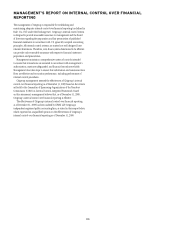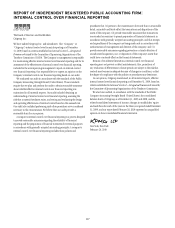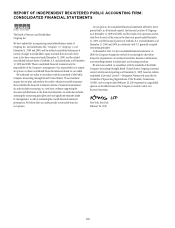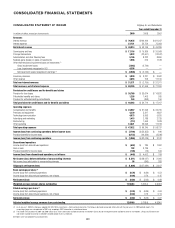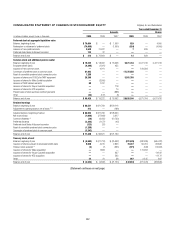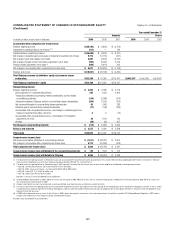Citibank 2009 Annual Report Download - page 123
Download and view the complete annual report
Please find page 123 of the 2009 Citibank annual report below. You can navigate through the pages in the report by either clicking on the pages listed below, or by using the keyword search tool below to find specific information within the annual report.113
The U.S. foreign tax credit carryforward period is 10 years. In addition,
utilization of foreign tax credits in any year is restricted to 35% of foreign
source taxable income in that year. Further, overall domestic losses that
Citi has incurred of approximately $45 billion are allowed to be reclassified
as foreign source income to the extent of 50% of domestic source income
produced in subsequent years, and such resulting foreign source income is in
fact sufficient to cover the foreign tax credits being carried forward. As such,
the foreign source taxable income limitation will not be an impediment
to the foreign tax credit carryforward usage as long as Citi can generate
sufficient domestic taxable income within the 10-year carryforward period.
Regarding the estimate of future taxable income, Citi has projected its
pretax earnings, predominantly based upon the “core” businesses that Citi
intends to conduct going forward. These “core” businesses have produced
steady and strong earnings in the past. During 2008 and 2009, the “core”
businesses were negatively affected by the large increase in consumer credit
losses during this sharp downturn in the economic cycle. Citigroup has
already taken steps to reduce its cost structure. Taking these items into
account, Citi is projecting that it will generate sufficient pretax earnings
within the 10-year carryforward period alluded to above to be able to fully
utilize the foreign tax credit carryforward, in addition to any foreign tax
credits produced in such period.
Citi has also examined tax planning strategies available to it in
accordance with ASC 740 that would be employed, if necessary, to prevent a
carryforward from expiring. These strategies include repatriating low-
taxed foreign earnings for which an assertion that the earnings have been
indefinitely reinvested has not been made, accelerating taxable income into
or deferring deductions out of the latter years of the carryforward period with
reversals to occur after the carryforward period (e.g., selling appreciated
intangible assets and electing straight-line depreciation), holding onto
available-for-sale debt securities with losses until they mature and selling
certain assets that produce tax-exempt income, while purchasing assets that
produce fully taxable income. In addition, the sale or restructuring of certain
businesses can produce significant taxable income within the relevant
carryforward periods.
Citi’s ability to utilize its deferred tax assets to offset future taxable income
may be significantly limited if Citi experiences an “ownership change,” as
defined in Section 382 of the Internal Revenue Code of 1986, as amended
(the “Code”). In general, an ownership change will occur if there is a
cumulative change in Citi’s ownership by “5% shareholders” (as defined in
the Code) that exceeds 50 percentage points over a rolling three-year period.
The common stock issued pursuant to the exchange offers in July 2009
and the common stock and tangible equity units issued in December 2009
as part of Citigroup’s TARP repayment did not result in an ownership change
under the Code. However, these common stock issuances have materially
increased the risk that Citigroup will experience an ownership change in
the future. On June 9, 2009, the Board of Directors of Citigroup adopted
a tax benefits preservation plan (the “Plan”). This Plan is subject to the
shareholders’ approval at the 2010 Annual Meeting. The purpose of the Plan
is to minimize the likelihood of an ownership change occurring for Section
382 purposes. Despite adoption of the Plan, future transactions in our stock
that may not be in our control may cause Citi to experience an ownership
change and thus limit Citi’s ability to utilize its deferred tax asset as well as
cause a reduction in its TCE and stockholders’ equity.
Approximately $15 billion of the net DTA is included in Tier 1 Common
and Tier 1 Capital.
See Note 11 to the Consolidated Financial Statements for a further
description of Citi’s tax provision and related income tax assets and liabilities.
LEGAL RESERVES
See the discussions under “Legal Proceedings” and in Note 30 to the
Consolidated Financial Statements for information regarding Citi’s policies
on establishing reserves for legal and regulatory claims.
ACCOUNTING CHANGES AND FUTURE APPLICATION
OF ACCOUNTING STANDARDS
See Note 1 to the Consolidated Financial Statements for a discussion
of “Accounting Changes” and the “Future Application of Accounting
Standards.”


